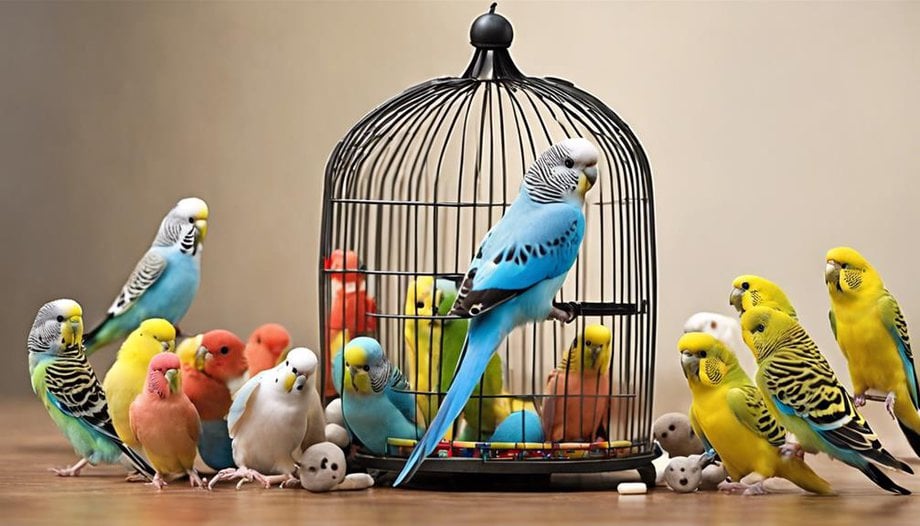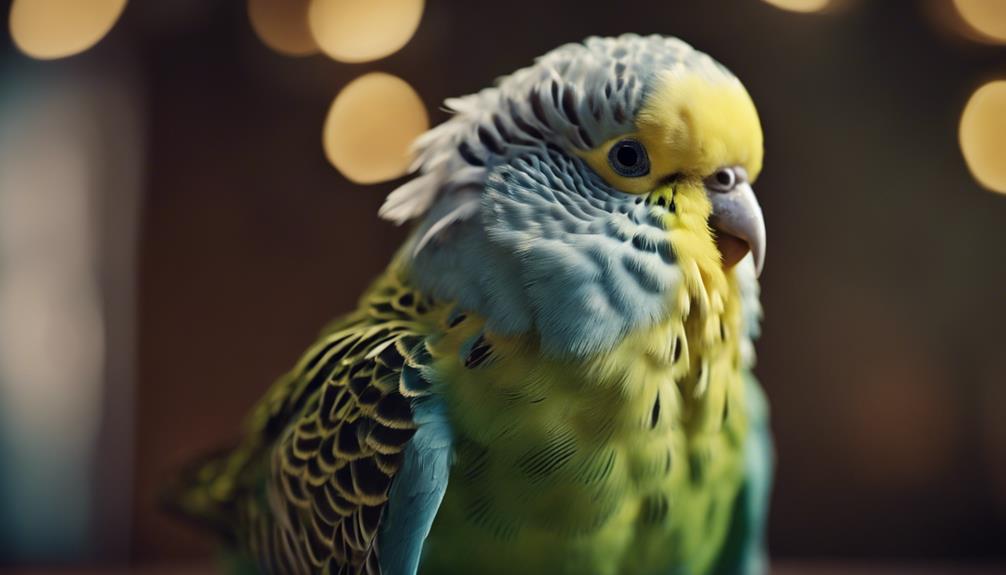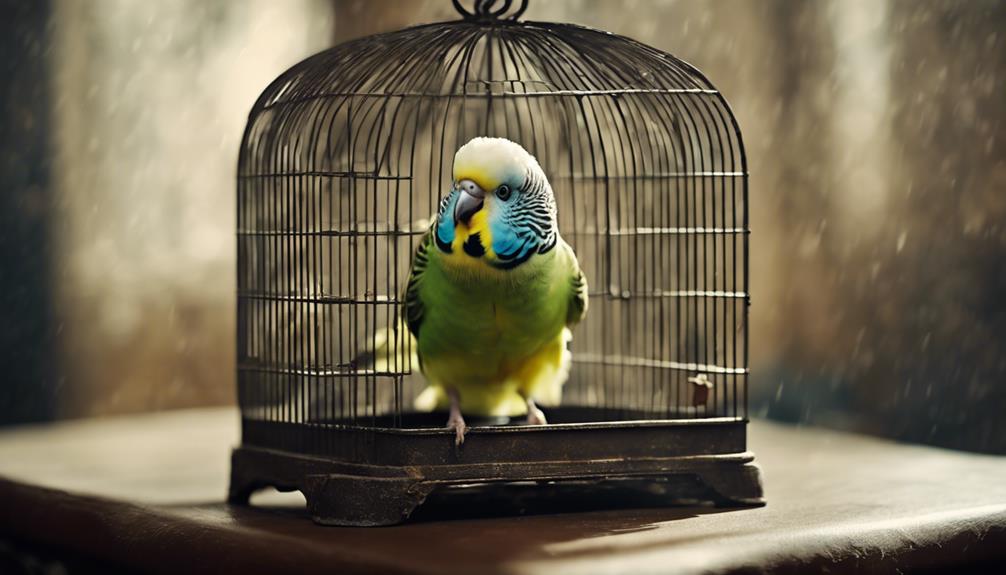How to Recognize the Need for More Space for a Budgerigar (Budgie)

Signs Your Budgerigar Needs More Space:
- Restlessness
- Behavior Changes
- Vocalization Patterns
Having enough space is crucial for the well-being of your budgerigar. When they exhibit signs of restlessness, behavior changes, or altered vocalization patterns, it may be an indication that they need more space to move around and explore. Make sure to provide a spacious and enriching environment for your feathered friend to thrive and stay healthy.
Signs of Restlessness and Agitation
If your budgerigar starts pacing back and forth in its cage or repeatedly fluttering around, these behaviors may indicate restlessness and agitation, signaling the need for more space. Budgies are active and social birds that require adequate room to move around freely. The cage size plays a crucial role in determining the activity levels and overall well-being of your feathered friend.
Space requirements for budgies are essential to consider as cramped living conditions can lead to stress and behavioral issues. A cage should be spacious enough to allow the bird to stretch its wings, hop from perch to perch, and have room for toys and other enrichments. Insufficient space can result in restlessness, excessive vocalization, and even aggression in these intelligent creatures.
Observing budgie behavior is key to understanding if they need more space. If you notice increased pacing, constant fluttering, or signs of agitation, it may be time to upgrade to a larger cage to provide a better living environment for your beloved pet. Remember, a happy and contented budgie will exhibit healthier behaviors and thrive in a spacious living area.
Behavioral Changes in Your Budgie

When observing your budgie, be attentive to any behavioral changes that could indicate its need for more space in its living environment. Feather plucking or excessive preening are common signs of stress or boredom in budgies. If you notice your budgie engaging in these behaviors more frequently, it may be a sign that it requires a larger cage or more stimulating environment.
Additionally, keep an eye out for unusual eating habits or weight loss. Changes in appetite or weight can signal underlying health issues or emotional distress in your budgie. Providing adequate space and enriching its environment with toys, perches, and activities can help alleviate these behavioral changes.
Increased Vocalization Patterns

Observing your budgie’s increased vocalization patterns can provide valuable insights into its communication needs and overall well-being. Budgies are known for their vocal nature, and changes in their vocalization frequency can indicate underlying issues such as stress or anxiety.
Here are some key points to consider:
- Vocalization frequency: An increase or decrease in your budgie’s vocal activity could be a sign of distress or discomfort.
- Pitch and tone variations: Changes in the pitch or tone of your budgie’s chirps and squawks may convey different communication cues.
- Volume levels: Loud or persistent vocalizations might suggest your budgie is trying to convey a specific message or is feeling anxious.
- Repetitive sounds: Constant repetition of certain sounds could be a way for your budgie to express its needs or seek attention.
- Silence: Unusual silence or a sudden lack of vocalization from your budgie might also be a cause for concern and should be monitored closely.
Physical Indications of Discomfort

Your budgerigar’s physical well-being is paramount in ensuring its happiness and health.
Watching for physical signs of discomfort is crucial for a responsible budgerigar owner.
Changes in behavior can often be indicative of underlying issues that may require attention.
Physical Signs of Discomfort
If your budgerigar displays frequent feather plucking, it may be a physical sign of discomfort. Other physical indications of distress in budgies include feather fluffing, wing twitching, head bobbing, and beak grinding. These signs are crucial to observe as they can signal that your bird is experiencing discomfort or pain.
If you notice any of these behaviors, it’s essential to address the underlying cause promptly to ensure your budgerigar’s well-being. Seeking advice from a veterinarian specializing in avian care can help determine the exact reason behind these physical signs and provide appropriate solutions.
- Feather fluffing
- Wing twitching
- Head bobbing
- Beak grinding
- Signs of discomfort or pain
Behavior Changes to Note
When budgerigars are experiencing discomfort, it’s important to pay attention to changes in their behavior as these can serve as physical indicators of their well-being. Body language and stress signals play a crucial role in understanding your budgie’s state of mind.
If your budgerigar is feeling cramped due to space constraints, you may notice behavioral issues such as excessive pacing, feather plucking, or increased vocalization. These signs can indicate that your budgie is feeling stressed or uncomfortable in its current environment. Providing more space and enriching their surroundings can help alleviate these issues and improve your budgie’s overall well-being.
Lack of Interest in Toys or Activities

Recognizing a budgerigar’s lack of interest in toys or activities can indicate potential boredom or dissatisfaction with its environment. This behavior could signal a need for more mental stimulation and physical engagement. Here are some key points to consider:
- Evaluate Toy Variety: Ensure a diverse range of toys is available in the cage to cater to different interests and play styles.
- Assess Cage Size: Make sure the cage is spacious enough to accommodate various toys and activities without feeling cramped.
- Encourage Activity Engagement: Spend time interacting with the budgerigar to encourage play and exercise.
- Provide Mental Stimulation: Introduce puzzle toys or foraging activities to keep the budgie’s mind active and engaged.
- Monitor Response: Observe how the budgerigar reacts to different toys or activities to understand its preferences better and tailor the environment accordingly.
Wing-Spreading Behavior

Wing-spreading behavior in budgerigars is a natural display that serves various purposes in their daily routines. Budgies engage in wing stretching exercises, which help them maintain their wing muscles and joints, ensuring they are in optimal condition for flight. This behavior also serves as a form of flight simulation, allowing budgies to exercise their wings and maintain their coordination, even when confined to a cage. In addition to physical benefits, wing-spreading behavior is essential for feather grooming. By spreading their wings, budgies can reach and preen their feathers effectively, keeping them clean and in good condition.
| Purpose | Description | Examples |
|---|---|---|
| Wing stretching exercises | Maintain wing muscles and joints | Stretching after naps |
| Social interaction | Communicate with other budgies | Displaying wings to others |
| Feather grooming | Preen and clean feathers | Reaching all feathers |
Understanding the significance of wing-spreading behavior can help budgie owners create an environment that supports these natural activities, ensuring the well-being of their feathered friends.
Impact on Overall Well-being

Budgerigars’ wing-spreading behavior plays a crucial role in maintaining their overall well-being by facilitating physical exercise, social interaction, and feather grooming. Ensuring adequate space requirements and cage size directly impacts their mental health and emotional well-being.
- Physical Exercise: Having enough space to stretch their wings and fly within the cage promotes physical activity, preventing obesity and promoting cardiovascular health.
- Social Interaction: A spacious environment allows for more natural movement, encouraging budgies to engage in play and social interactions with cage mates, which are essential for their mental stimulation and overall happiness.
- Feather Grooming: Sufficient space enables birds to groom their feathers properly, preventing issues like feather plucking and maintaining a healthy plumage.
- Mental Health: Inadequate space can lead to stress, anxiety, and behavioral problems in budgerigars, significantly impacting their mental well-being.
- Emotional Well-being: Providing a spacious cage allows budgerigars to exhibit natural behaviors, reducing boredom and promoting emotional stability.
Frequently Asked Questions
How Can I Train My Budgie to Be More Comfortable With a Larger Living Space?
To help a budgie adjust to a larger living space, start with behavioral training and enrichment activities. Gradually introduce cage upgrades and incorporate flight training. Patience and positive reinforcement will aid in making the transition smooth and comfortable for the bird.
Are There Specific Types of Toys or Activities That Can Help Alleviate the Need for More Space for My Budgie?
Enrichment toys and climbing structures can provide mental and physical stimulation for budgies in limited spaces. These toys offer opportunities for exercise, play, and mental engagement, helping to alleviate the need for more physical space.
Can Introducing a Companion Bird Help Address the Need for More Space for My Budgie?
Introducing a companion bird can improve your budgie’s mental well-being through bonding exercises and social interaction. However, it’s crucial to ensure adequate space by considering cage upgrades to accommodate multiple birds comfortably.
Are There Any Potential Health Risks Associated With Keeping a Budgie in a Cramped Living Space?
Keeping a budgie in a cramped living space can pose health risks due to poor ventilation, leading to respiratory issues. Additionally, the psychological impact of limited space can cause stress and behavioral problems in the bird.
What Are Some Creative Solutions for Providing More Space for My Budgie in a Limited Living Environment?
Ever thought of transforming a cozy corner into a bird paradise? Room dividers can create new zones for your budgie. Vertical perches offer space-efficient roosting. Hanging toys and climbing structures enhance their environment, making every inch count.











